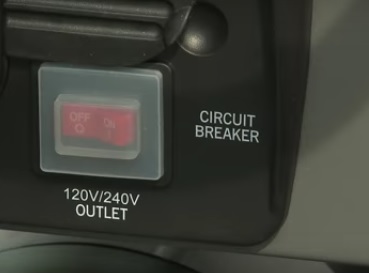![]()
Troubleshooting Generator Problems [Let’s Fix it!]
DISCLAIMER: AS AN AMAZON ASSOCIATE I EARN FROM QUALIFYING PURCHASES. THIS POST CONTAINS AFFILIATE LINKS THAT WILL REWARD ME MONETARILY OR OTHERWISE WHEN YOU USE THEM TO MAKE QUALIFYING PURCHASES. FOR MORE INFORMATION, PLEASE READ MY EARNINGS DISCLAIMER.
Troubleshooting your generator has to start with a basic understanding that if you did not store it properly, you will have a problem. If gasoline was NOT drained and you kept it in storage for a while, your carburetor and gas tank will require some deep cleaning. On the other hand, a problem could be as simple as not opening a fuel valve or putting a choke lever in the right position.
Whether you recently purchased a gasoline generator or just dug one out of the garage (that sat there maybe for 10 years) you need to know how to handle problems as they come up. In this article I will go over the following problems:
-
- The generator will not start
- The generator has no electrical output
- The generator is operating with difficulty
Problem #1. The generator will not start
Before we start troubleshooting possible causes of this problem, let’s make sure you prepared your generator correctly:
- You did not forget to add gas, did you? Probably not, but just in case. If you did forget, just fill it up and you are good to go! It is usually recommended to use 87 or higher octane rating UNLEADED gas and make sure not to let any water, dirt, or dust inside your fuel tank.
- Old fuel could cause startup problems. Stale fuel is a common cause for the generator not starting and it could happen if you just took your generator out of the garage with some gasoline inside. As a side note, NEVER store a generator for long-term with gasoline in it! Basically, if this is your case, all you have to do is to drain your tank and add fresh fuel.
- Old oil in the carburetor could cause startup problems. If you suspect that you have old oil in your carburetor (this is especially true if you are trying to start a generator that was not used for quite a while), try opening the drain screw and run it until new oil starts running.
- Does your generator have any load while you are trying to start it up? You need to remove all the loads during the startup. If you are trying to start your generator while it is loaded, it may not start.
- Check your oil levels. There is a sensor that will alert you if your level of oil is too low. It is generally an indicator light that will be ON if triggered. Low oil levels could be checked and if insufficient, add oil.
- Check your coolant levels. Some generators have this kind of sensor that will NOT let you start the engine until it is at the proper level.
** Warning! Very often generators will come from the manufacturer with NO OIL in them! Don’t forget to add oil, because the engine will NOT start without it. If the motor will somehow run without oil in, NO warranty will cover damages!
** Important! There could also be a problem with the LOW OIL indication that is being triggered by a faulty sensor or if the generator is not placed flat on the surface. Any incline can activate the sensor and prevent the generator from starting.
So, what do you do if your petrol (or gasoline) generator is not being able to start? Here is a nice video on that:
Solution #1. Check the ignition switch
Is your engine switch in the ON or OFF position? If it’s OFF, then turn it ON!
Solution #2. Check the fuel valve
If it’s in a closed position, then OPEN it! It could also have indications like ON/OFF. If so, then turn it ON.
Solution #3. Check the choke lever
If you are starting a cold engine, you may need to CLOSE the choke lever (or put on FULL CHOKE position). If you are restarting a warm engine, move your choke lever to HALF-CHOKE or RUN position.
At this point, if your engine does NOT start, OPEN the choke and close again. After repeated attempts that failed, it’s time to troubleshoot your spark plugs.
Solution #4. Spark plug test
- Is your spark plug dirty? If so, clean it.
- Is your spark plug broken? If so, replace it.
- Is your ignition coil defective? If everything is fine with your spark plugs, you can use an ignition coil tester. If your ignition coil is defective, replace it.
Solution #5. Carburetor
Your carburetor could be clogged due to the old fuel that was inside the tank that got thicker than it is supposed to be. This will be a problem if you kept the fuel in the tank while the generator was in storage.
If you have trouble starting your generator even after you changed your gasoline and cleaned a fuel tank, you may want to clean the carburetor as well.
Problem #2. The generator has NO electrical output
Good suggestions came from the video by repairclinic.com. They recommend first checking the generator’s CIRCUIT BREAKER (or Safety Switch):

In order to reset the circuit breaker, you generally need to:
- Unplug ALL the devices from the generator
- Turn your switch (or breaker) to the ON position.
** If your switch FAILS to reset, you might be dealing with faulty wiring or appliance that needs to be taken care of (see the section about generator overload below). Even if you were able to flip the breaker back, you may still have an overload problem that could come back at any time when you will turn all your equipment ON.
To be on the safe side, it may be a good idea to limit the number of devices that are plugged in. To do this, unplug them all, stop the generator and start it with a reduced load.
The video below will go over why the generator could be producing no current at all (starting @2:07):
![]()
Other reasons for the generator not producing energy at all may include rotor losing residual magnetism that could be reintroduced by a process called: “Flashing the field” (see video above @ 2:12). You can lose residual magnetism in the following situations:
- Your generator was not used for a long time.
- Your generator runs without load for a long time.
- Your generator is OFF while being connected to the load.
There are two common solutions to restoring the generator’s magnetism:
- Using a 12-volt DC battery (as shown in the video above).
- Using a drill, which will generate electrical current and restore magnetism as shown in the video below:
![]()
If none of these help you, you may want to inspect the brushes and replace them (worn out or damaged brushes) if necessary.
Solution #1. Brushes
Inspect and check your brushes to make sure they are in good working condition. This is how you take the brushes down and put them back (or replace them):
Solution #2. Receptacle
Before we go any further, you may want to check the actual receptacle (or an electrical outlet) of the generator. This can be done with a multimeter or volt-meter.
Solution #3. Voltage regulator
If everything is fine with brushes, check your voltage regulator. You can ask a professional to assist you with that one.
Solution #4. Rotor and stator
Even though it is not a common problem if nothing seems to help get your generator up and running, you may be dealing with a faulty rotor and stator. This may be complicated for most people and professional service is advised.
Problem #3. The generator is operating with difficulty
If your DC Safety Switch or Breaker does not reset, it is probably due to circuit overload caused usually by:
- Too much voltage is demanded by your devices
- You have a short circuit someplace
The basic troubleshooting procedure for both cases is about the same because you will need to know which device is causing a problem and how much is too much! To figure that one out you will need to:
- Determine the device that overloads. You can find a device that overloads your generator by plugging all your devices in and making it less each time until your circuit will STOP tripping.
- Determine the faulty device. You can find out which device is giving your problems by plugging them in one by one and see which one will trip the circuit breaker. Once found, check for bad wiring or take it to a repair shop. Of course, replacing a device with a new one is always an option.
** As a side note, you may want to replace some older devices that you are trying to run off the generator with newer versions because older ones are known for higher energy demands.
Solution #1. Generator overload
Once you find out what overloads your generator, just remove it and everything should be working fine. Check your wires and make sure they are NOT damaged, frayed, or bare.
Dealing with a short circuit is very dangerous and it should be handled by a professional, especially if you have limited electrical knowledge.
Solution #2. Generator is overheating
There could be several reasons for the generator being overheated:
- It is overloaded. So the basic solution is to reduce load.
- It has insufficient ventilation. If you are using it in dusty locations, you may have a problem with a clogged filter. Your generator needs to receive enough airflow to function properly (gas to air ratio).
- Its exhaust is blocked and the spark arrestor is dirty. Both should be checked and cleaned.
Solution #3. Generator keeps stopping
There are several reasons why your generator would stop on you. They are very similar to those why it would not start in the first place:
- Oil Levels. Your oil level got low.
- Flat surface. The generator required a leveled surface to sit on to avoid the “low oil” sensor being triggered. Blocking the generator’s wheels to prevent sliding a shifting is also recommended.
- Shielded or indoor location. The reason for this is that generators cannot be exposed to rain, snow, and direct sunlight to avoid electrocution. If used indoors, safety precautions are required.
- Clogged air filter. The generator cannot operate in extremely dirty or dusty conditions and will overheat if good airflow is not supplied to the machine.
- Clogged fuel filter. If the fuel filter is not allowing gasoline (or petrol) to go through the motor, you will have a problem with the engine stopping.
- Spark plugs. You can diagnose a spark plug problem with a multimeter or make a test like in the video below:
![]()
I hope that my problem-solving guide will help you deal with the most common petrol (gasoline) generator problems.


